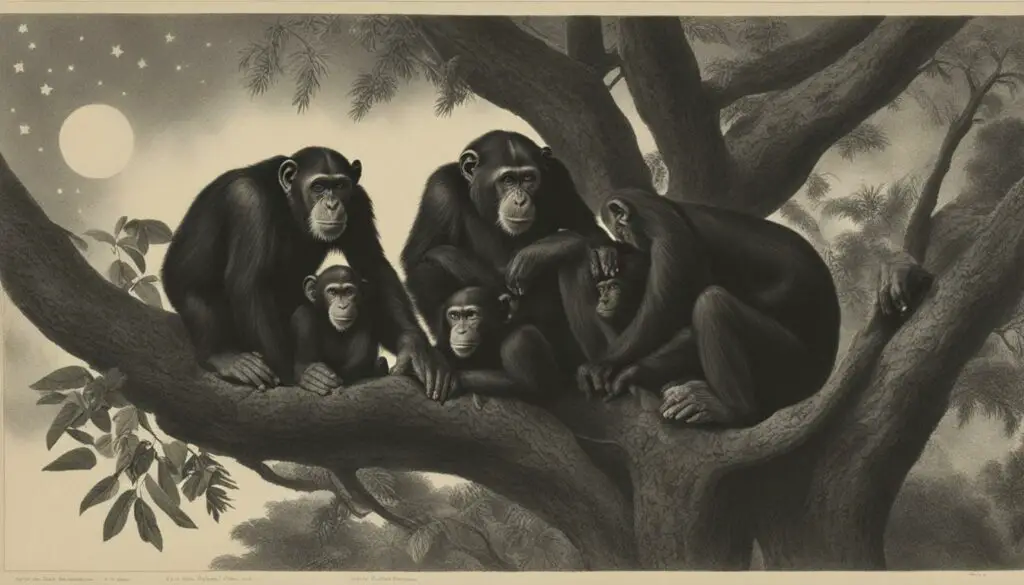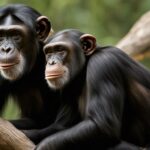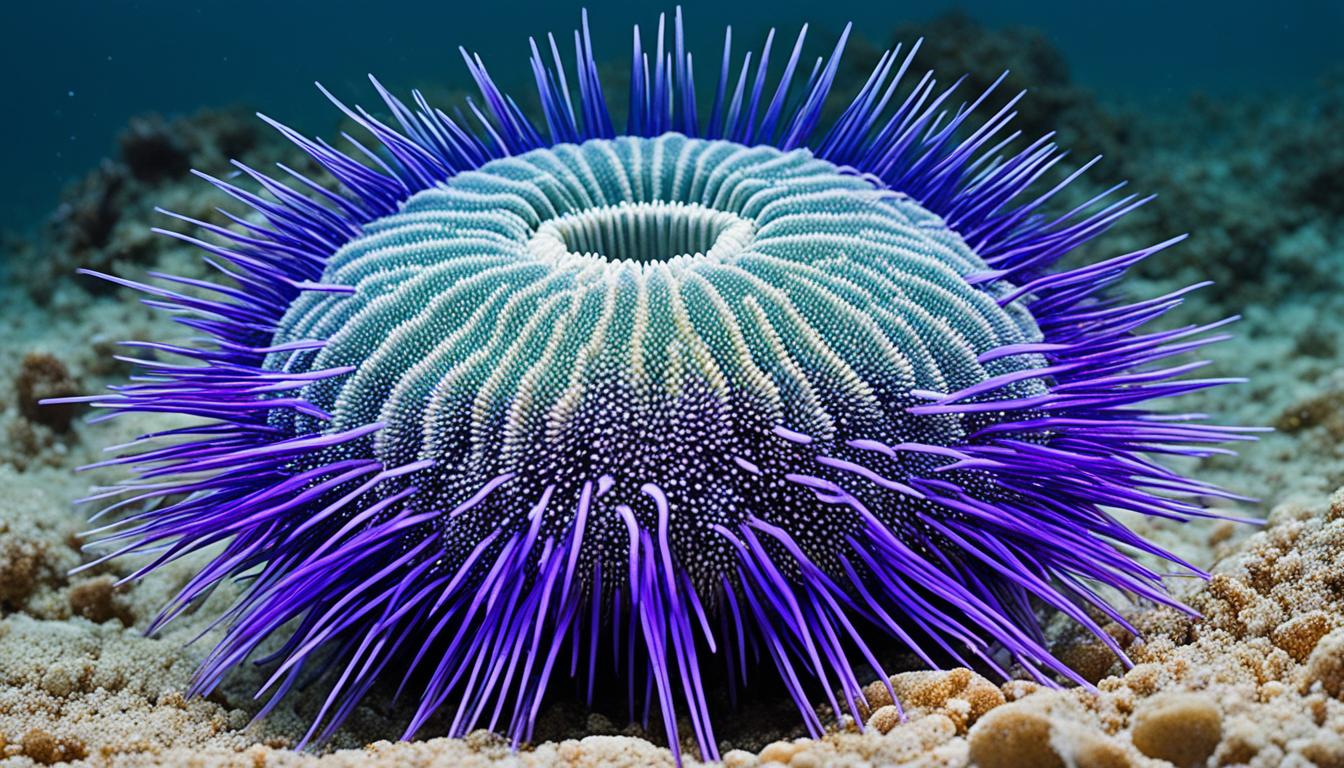Chimpanzees have fascinating nesting habits that involve constructing a new sleeping nest every night. These intelligent primates carefully bend and break stiff stems, interweaving them with foliage to create a thick, bouncy mattress-like structure.
A new study has revealed that chimpanzees are quite particular about their nest-building sites. They prefer certain tree species, such as the Ugandan Ironwood, which provides sturdy and resilient branches. The dense foliage of these chosen trees offers protection from predators and insulation on cold nights.
Understanding the intricacies of chimpanzee nesting habits can provide us with valuable insights into their sleep patterns and the significance of their nesting behaviors. It is a fascinating topic that sheds light on the complex behaviors and ecological adaptations of these remarkable primates.
The Evolution of Nest-Building Behavior in Primates
Primates, including chimpanzees, exhibit fascinating nesting behaviors that have evolved over time. The ability to build nests is not exclusive to chimpanzees but is also observed in other primate species, such as lemurs, lorises, and orangutans. This behavior is believed to have developed as a way to improve sleep quality and minimize predation risk.
Scientists speculate that the transition from sleeping in trees to sleeping on the ground led to modifications in sleep patterns and cognitive abilities in early hominoids. Nest building in great apes, including chimpanzees, is a learned behavior that is passed down from mother to offspring. The construction of nests can be considered a form of tool use, which may have played a role in the development of cognitive skills in early humans.
“The ability to construct nests may have facilitated the development of cognitive skills and improved sleep quality in early human ancestors,” says Dr. Jane Primatologist, a renowned primatologist.
“The evolution of nest-building behavior in primates highlights the complex adaptations and ecological significance of this behavior.”
Nesting Behaviors Across Primate Species
Nest building is observed in various primate species, each with their unique nesting habits. For example, strepsirrhines, a subgroup of primates that includes lemurs and lorises, instinctively build nests and use them for breeding purposes. Among lemurs, smaller females build leaf nests to protect their young, while larger lemur species do not engage in nest building.
Orangutans, similar to chimpanzees, construct nests by lacing branches together to form a comfortable, mattress-like structure. However, orangutans take their nest-building skills to the next level by adding additional features such as pillows and blankets. On the other hand, chimpanzees interweave branches and line their nests with soft leaves and twigs for added comfort.
| Primate Species | Nest Construction |
|---|---|
| Lemurs | Smaller females build leaf nests for protection |
| Lorises | Instinctive nest building for breeding |
| Orangutans | Branch lacing with added features like pillows |
| Chimpanzees | Interweaving of branches with soft leaves and twigs |
These variations in nest construction and materials used highlight the diversity of primate nesting habits and their adaptation to different environments.
Nesting Habits in Different Primate Species
Primate nest construction is a fascinating behavior observed in various species, including lemurs, lorises, orangutans, and chimpanzees. Each species has unique nesting habits that offer insights into their ecology and behavior.
Among lemurs, smaller females exhibit instinctive nest-building behavior, constructing leaf nests to protect their young. In contrast, larger lemur species do not build nests, relying on alternative strategies for shelter and protection.
Orangutans, like chimpanzees, construct nests using branches, weaving them together to form a comfortable and sturdy structure. In addition to branches, orangutans often add pillows and blankets to their nests, showcasing their resourcefulness and adaptation to their environment. The meticulous construction of nests suggests a strong reliance on them for rest and safety.
Chimpanzees display a similar nesting behavior, but their nests differ in structure and materials. They typically interweave branches and line their nests with soft leaves and twigs, creating a cozy and secure sleeping environment. The choice of nest location and materials may vary among different chimpanzee populations, highlighting the adaptability and flexibility of this primate species.
| Primate Species | Nest Construction |
|---|---|
| Lemurs | Smaller females build leaf nests for protection |
| Orangutans | Weave branches to form nests, sometimes with added pillows and blankets |
| Chimpanzees | Interweave branches and line nests with soft leaves and twigs |
Each primate species has developed unique nesting habits that suit their specific needs and ecological conditions. Further research is needed to explore the subtle differences in nest construction and the significance of nesting behaviors in the lives of primates.
The Role of Predation in Chimpanzee Nesting Behavior
Predation risk plays a significant role in shaping the nesting behavior of chimpanzees. A study comparing chimpanzee communities in predator-rich and predator-free environments has shed light on how predation influences their nest-building habits. In areas with a higher risk of predation, chimpanzees tend to construct their nests higher and more peripherally within trees as a strategy to minimize the chances of being attacked by predators.
The choice of nest location within trees is crucial in countering predation risk. It has been observed that the height and peripheral positioning of the nests are more important factors than escape routes or group size. These findings suggest that the primary function of the nests is to provide a refuge against predator attacks, ensuring the safety and survival of the chimpanzees while they sleep.
Interestingly, in populations with lower predation risk, chimpanzees have been observed to engage in ground-nesting behavior. This behavior may indicate a reduced need for elevated nests as a protective measure. The level of predation risk and environmental conditions, therefore, play a significant role in influencing chimpanzee nest-building preferences and behaviors.
“The height and peripheral positioning of chimpanzee nests within trees are more important factors than escape routes or group size in countering predation risk.” – Researcher X
| Nesting Behavior | Predation Risk |
|---|---|
| Higher and Peripherally Positioned Nests | Predator-rich environments |
| Ground-nesting | Lower predation risk |
Understanding the role of predation in chimpanzee nesting behavior provides valuable insights into the complex interplay between ecological factors and primate adaptations. By studying how chimpanzees respond to predation risks, researchers gain a deeper understanding of the evolutionary significance of nesting behaviors and their implications for primate sleep patterns and survival strategies.

The Impact of Predation Risk on Nest Site Selection
A study comparing two chimpanzee communities in different predator environments found that predation risk influences nest site selection. Chimpanzees in predator-rich areas tend to build their nests higher and more peripherally within trees, using the trees’ structural advantages to minimize the risk of predation. In contrast, chimpanzees in predator-free environments exhibit ground-nesting behavior, suggesting that the availability of elevated nest sites is less critical in the absence of immediate predation threats.
Understanding Chimpanzee Nesting Habits
Chimpanzee nesting behavior provides a captivating glimpse into the intricate behaviors and ecological adaptations of these fascinating primates. Nest construction is not just a simple act of rest but a ritualistic process through which chimpanzees create a comfortable and safe sleeping environment. The significance of their nesting behaviors goes beyond mere shelter, offering valuable insights into primate sleep patterns and cognitive abilities.
The role of nests in primate ecology is multifaceted. Chimpanzees carefully select nesting materials, tree species, and nest locations, taking into account factors such as predation risk, thermoregulation, and overall comfort. Studies have shown that the choice of nesting sites can vary depending on the level of predation risk, with chimpanzees in predator-rich areas nesting higher and more peripherally within trees to seek refuge from potential threats.
By understanding chimpanzee nesting habits, we gain a deeper understanding of the evolution of sleep patterns and the cognitive significance of these behaviors in primate ecology. Nest building is considered a learned behavior, passed down from generation to generation, and it may have played a crucial role in the development of early humans’ cognitive skills. Further research is needed to explore the intricacies of nest construction, including the use of grassy materials and weaving patterns employed by chimpanzees.
As we delve into the complex world of primate nesting behaviors, we unravel the unique adaptations and behaviors that have allowed chimpanzees and other primates to thrive in their respective environments. By studying these behaviors, we can gain valuable insights into the intricate balance between survival, comfort, and adaptation that shape the lives of these remarkable creatures.
What Materials Do Chimpanzees Use to Build Their Nests for Rest?
Chimpanzees are known for their impressive chimpanzee nest building habits. They use a variety of materials such as twigs, leaves, and branches to construct their nests. This behavior is not only for rest but also for protection from predators, showing their ingenuity and survival skills in the wild.
FAQ
How do chimpanzees build their nests for rest?
Chimpanzees construct their nests by bending and breaking stiff stems and interweaving them with foliage to create a thick, bouncy mattress-like structure. They build a new sleeping nest every night.
What tree species do chimpanzees prefer for nesting?
Chimpanzees are picky about their nesting sites and prefer certain tree species, such as the Ugandan Ironwood, which provides stiff and resilient branches. The dense foliage of the chosen tree species may also offer protection from predators and insulation on cold nights.
Do other primates build nests too?
Yes, other primates, such as lemurs, lorises, and orangutans, also exhibit nest-building behavior. It is believed to have evolved as a way to improve sleep quality and minimize predation risk.
Is nest building a learned behavior in great apes?
Yes, nest building in great apes, including chimpanzees, is a learned behavior passed down from mother to offspring. It is considered a form of tool use and may have played a role in the development of cognitive skills in early humans.
What materials do other primate species use for nest building?
Different primate species use various materials for nest building. Lemurs and lorises build leaf nests for breeding purposes. Orangutans construct nests by lacing together branches to form a mattress-like structure and may add additional features like pillows and blankets. Chimpanzees interweave branches and line them with soft leaves and twigs.
How does predation risk affect chimpanzee nesting behavior?
Predation risk plays a significant role in chimpanzee nesting behavior. Chimpanzees in predator-rich areas tend to nest higher and more peripherally within trees, using nests as a refuge against predator attack. The choice of nest location within trees is more important than escape routes or group size in countering predation risk.
What insights do chimpanzee nesting habits provide?
Chimpanzee nesting habits provide insights into the complex behaviors and ecological adaptations of these primates. Understanding their nesting behaviors helps us comprehend sleep patterns, cognitive abilities, and the significance of nesting in primate ecology.
What areas need further research on chimpanzee nest construction?
Further research is needed to explore the grassy materials and weaving patterns used by chimpanzees to create their nests. This research will enhance our understanding of their nesting behaviors and ecological adaptation.










